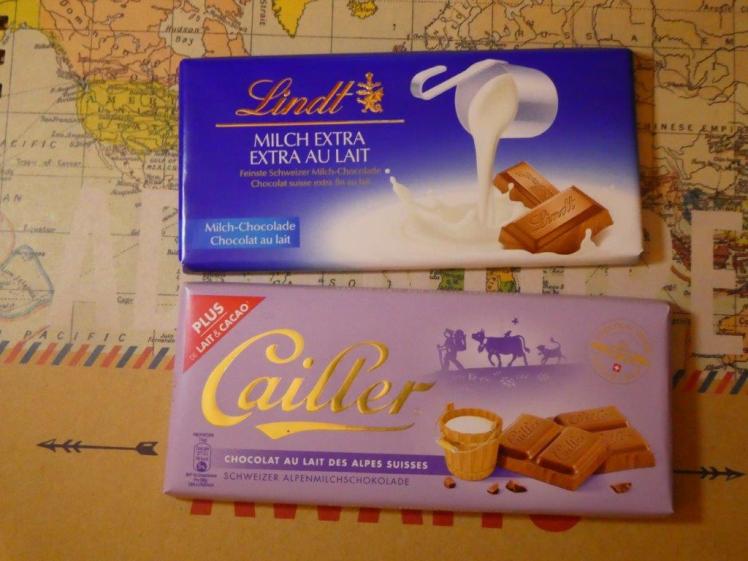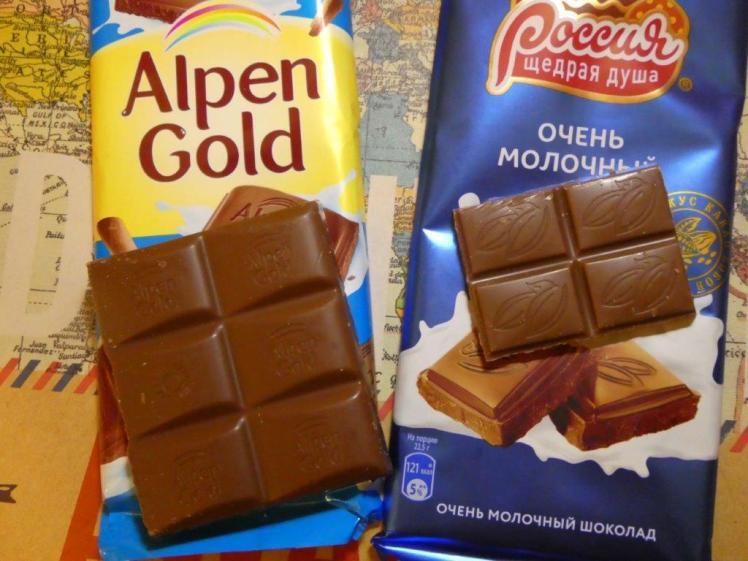Today I’m taste-testing two very different lots of chocolate. In the red corner, we have two brands of Russian chocolate, picked up in the supermarket on my first evening in Moscow, carried around Russia for nearly three weeks and then left in my room for over a month. In the…. also red corner, we have two brands of Swiss chocolate, brought home by my parents last weekend. This should be an easy win for Switzerland, the country known for chocolate, milk and cuckoo clocks (although cuckoo clocks are not actually from Switzerland). Russia’s definitely the underdog here – Russian cuisine is limited to borchst and black rye bread in international eyes and it’s definitely not known for its chocolate. But Russia may have a secret weapon up its sleeve…
So, we have four chocolates. We have Alpen Gold, which is apparently a popular premium brand in Russia and I spot on the back that it’s owned by Mondelez. I think the other one says Россия in that inconvenient Italic that turns familiar letters into inconvenient letters. But that’s what it seems to say in the ordinary type under the fold at the back and that’s Cyrillic for Rossiya. From the fact that the logo is one of St Basil’s onion domes, I’m going to guess that this is tourist chocolate. And then we have Lindt – international brand that everyone knows – and Cailler, once an independent Swiss brand, now owned by Nestle.
Appearance


Both Russian chocolates are packed in a sort of plasticky wrapper which you can reseal and stick back down. The Swiss ones are in a sealed foil wrapped inside a paper wrapper. I’m going to assume that makes the Russian ones more hardwearing – and having been lugged on five flights and two trains, the packaging is as pristine as the day I bought them. I suspect the Swiss paper packaging wouldn’t stand up to quite as much packaging.
The Russian ones are brighter and more eye-catching. Cailler is positively sophisticated, with that pale lilac and curly fonts and gold foiling. Switzerland seems to prefer the landscape layout – but now I come to think of it, so do most countries (except some of the Lindt ranges) so perhaps Russia is unusual for favouring portrait chocolate.


They’re all much the same colour inside, although Lindt is a little lighter, presumably because this is the Extra Milk variant. I’m not certain but I think this is a Switzerland-only variant; everyone else seems to get the Extra Creamy flavour of the Excellence range.

Taste
Alpen Gold. I like it, although that’s no great surprise. It’s owned by Mondelez and whatever you have to say about Kraft/Mondelez, they do hoover up good chocolate. It’s creamy and chocolatey and I could eat plenty of this.
Rossiya. I think this is my least favourite of the lot. On its own, I might not have noticed but I’ve placed it between the good Alpen Gold and the Lindt and a lot of chocolate would suffer in that position.
Lindt. Ah, well, this is a market leader for a reason. That said, the extra milky version isn’t my favourite. It’s a bit too milky. It’s fine. Everyone loves Lindt but I think this one’s a bit too milky for my taste.
Cailler. This was my favourite brand when I lived in Switzerland, although I have to say that this is a chocolate that tastes better in the large bars – texture does play a part and the larger chunks that break off a larger bar are more pleasing. I also really liked the bubbly version. Yes, this is also a good one. Maybe not quite rich enough.
Verdict
I think from this batch, Alpen Gold is my favourite. Yes, the Russian chocolate beats two Swiss brands. It’s just that bit more chocolately. I’m absolutely a milk chocolate person which is why there’s no dark chocolate in this batch but I think I prefer them without extra milk. Rossiya least favourite. Cailler second and Lindt third. Wish I’d bought more Russian chocolate when I was out there but I wanted to save it for this tasting blog so I didn’t.
By the time you ready this, I’ll have been to Gdansk and a short weekend in Paris will be almost upon me so although I’m making no promises, I might do a Polish chocolate vs French chocolate next.